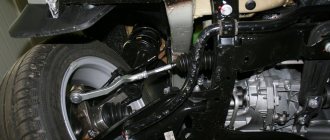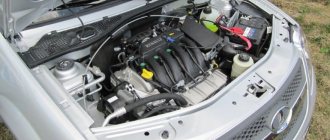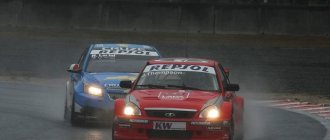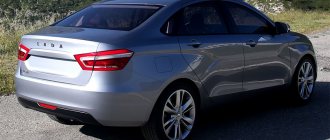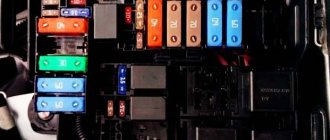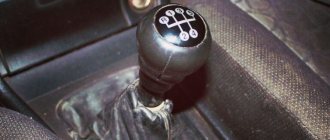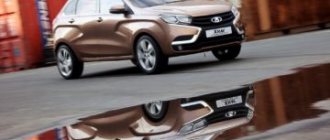A video clip with the title “Birth of LADA Vesta SW Cross | The birth of LADA Vesta SW Cross". The body production process, as well as the subsequent assembly of the station wagon, is demonstrated in less than 2 minutes. But even in such a short time you can see a lot of interesting things.
At the beginning of the video, they show the Lada Izhevsk plant, where Lada Vesta cars are assembled. Then they demonstrate how the body is welded, after which it is sent to the painting shop. The painted body goes to the assembly line, where factory workers assemble the interior, install the engine, suspension and other elements. The video also shows the glazing process and a display with the production plan (407 cars per day).
Let us remind you that earlier video clips appeared online about how the Lada Vesta SW “Say Yes to Life” advertisement was filmed.
Keywords: Lada Vesta Cross
Found an error? Select it and press Ctrl+Enter..
The assembly of the Lada Vesta is based on the experience of foreign professionals using robotic technology, which allows us to assemble a high-quality modern car. Conveyor assembly of a car is not much different from the assembly of foreign automakers. The first batch of Lada Vesta sedans was assembled in Izhevsk at the beginning of 2015. Work on the car is ongoing continuously. The build quality is constantly improving and the shortcomings of the first series are being eliminated so that a high-quality car reaches the dealer's showroom.
Production Lada Vesta
Kolesa.ru visited the production of Lada Vesta.
All Lada Vesta facts are here: https://www.kolesa.ru/article/vse-fakty-o-lada-vesta-2015-02-03 Test drive LADA VESTA. The most voluminous and interesting: https://www.youtube.com/watch?v=zQvwB6X4U7Q
Test drive of Lada Vesta from AVTOVAZ President Bo Andersson: https://www.youtube.com/watch?v=r1NkCPg5GuU
Text test drive Lada Vesta. A huge number of photos and expert opinion: https://www.kolesa.ru/test-drive/pervyj-testdrajv-lada-vesta-2015-09-25 Live report from the start of production of Lada Vesta: https://www.kolesa. ru/news/novaja-lada-vesta_-prjamoj-reportazh-so-starta-serijnogo-proizvodstva-2015-09-24
History of the car plant in Izhevsk
A little about the plant: since 1965, they produced Moskvich, Izh-Oda, VAZ classics, heels, then Kia, which will be discussed in a separate article, because I managed to visit the museum of the enterprise.
After the 2008 crisis, things went really badly - the company laid off employees, there was no work, and bankruptcy took place. In 2010, there was a plan to start producing Koreans again, but there was a sleight of hand and the enterprise was bought by AvtoVAZ, albeit with money from the federal budget (that is, ours), as a result, production was modernized with this money, the production of Grants began, this happened until 2015 year, when the plant refocused on producing Vesta.
At the moment, only Vestas are produced at this plant; 107,000 of them are assembled per year, which is not so little. But, of course, before Soviet times the numbers didn’t even come close. Well, despite the cheerful figures in the statistics - they say the production and sales of West are growing, revenue is growing, the share of Lada is growing, everything is not so simple, the fact is that with revenue growth, production costs are growing much faster (and there will also be a separate article about this ), this is due to the fact that many spare parts are imported, and the ruble, as you know, is falling and falling, in addition, this is due to the huge general inefficiency of the enterprise, a large amount of manual labor.
As a result, for 2021, the losses of Lada Izhevsk almost reached a billion rubles; in 18-19, apparently (no data yet), it will be at the level of one and a half billion. Accounts payable - 8.5 billion, at the end of the year will be at the level of 10 billion, accounts receivable - almost 7 billion rubles. That is, at the moment there are many times more debts than assets. All this data is publicly available in the quarterly reports of both AvtoVAZ and Lada Izhevsk, you can check it.
In principle, in a competitive economy this means only one thing - bankruptcy of the enterprise and its closure. But.. we live in an amazing country, therefore, with the help of injecting our money into the economy of a Japanese-French enterprise (who doesn’t know, AvtoVAZ, which owns the Lada Izhevsk, itself belongs to the Renault-Nissan-Mitsubihsi alliance and is a foreign company that owns in our country there is only an assembly plant) the enterprise exists and in such conditions is trying to develop, which, in principle, turns out: there is growth, but losses are still growing...
How Lada Vesta is made.
How Lada Vesta is made.
LADA Vesta is a Russian compact small car that AvtoVAZ has been producing since September 25, 2015. Replaced the LADA Priora family in the automaker's model line. Vesta sales started on November 25, 2015. Video taken from the ALL NEW LADA channel.
Read more: Antenna for Chevrolet Niva
Subscribe to the Virtuoso channel - https://www.youtube.com/channel/UCOzEpNaKHDOO_eZTUmXulPw
Ceremonial launch
Interview with Vesta project director Kristina Dubinina
Beginning of Lada Vesta body assembly - photo, video
Moscow, September 11. The Russian automobile manufacturer has released a video showing the process of mass production of the new LADA Vesta SW and Vesta SW Cross models.
Serial production of Vesta SW and Vesta SW Cross cars has begun today. For the serial production of Vesta SW and Vesta SW Cross, the plant launched the production of 79 new parts. In addition, the welding, painting and assembly shops were modernized. Before the start of mass production, Vesta SW and Vesta SW Cross were tested in laboratory and road conditions. According to the company, the new cars will go on sale by the end of autumn.
The birth of LADA Vesta.
#LADA #LADA #LADAVesta
This issue is dedicated to the car that won the hearts of people. We give him our full attention, we can't take our eyes off him when he drives by. In this video the main character is LADA Vesta. This car is a new generation. It is fast-paced, bright and stylish. The new LADA corporate style is easily recognizable in LADA Vesta. A rich palette of colors emphasizes the impressiveness of this car. So would you like to see how this car is born? It is worth noting that the entire LADA Vesta family is assembled in Izhevsk. And today we will show you how the LADA Vesta sedan is born and grows into a full-fledged car.
LADA Izhevsk is a modern production site that meets the highest automotive industry standards. It is here that one of the most popular and in demand Russian cars today is produced - LADA Vesta. We will show you the complete assembly cycle. The painted body is a finished car.
0:07 — Assembling a LADA Vesta car at AVTOVAZ, the whole process
Official website of LADA: https://lada.ru LADA group VKontakte: https://vk.com/lada LADA Vesta group VKontakte: https://vk.com/vestaswx Instagram @allnewlada: https://www.instagram. com/allnewlada/ LADA on Facebook: https://www.facebook.com/LADA/ Twitter LADA: https://twitter.com/allnewlada Issue “The Birth of LADA. Welding the body of LADA Vesta.” see the link: https://u.to/7V_dEw LADA Vesta: https://u.to/xVTLEg
#LADAVestaSE #LADAVesta #VestaSE #VestaSedan #VestaSedan #VestaSedan #LADAVestaSedan #LADAVestaSedan #lada #granta #ixrey #vesta #priora #kalina #largus #lada #granta #xray #vesta #priora #kalina #4х4 #4х4 #largus
Assembly
The bodies leaving the painting shop again lose their doors. This was done, firstly, to make assembly easier inside and outside the cabins, and secondly, a separate door assembly area increases work efficiency and reduces the likelihood of defects. The finished doors are returned to the same body from which they were removed.
Conveyor workers place the engine, instrument panel, seats and all the other stuffing on the cars moving around the ring. The process looks fascinating: several people are working on one machine at the same time - here everyone has their own area and their own tasks. An electronic control system has been created in the assembly shop; manipulators and robots help people.
The new car will have to go through five main test posts:
- adjustment of wheel geometry and headlights
- vehicle dynamic test bench
- wheel side slip test setup
- electronic control systems tester
- Leak test chamber.
The vehicle then goes through the AVES quality system. At the exit there is a special area where testers drive new cars back and forth. People's work is interesting and creative.
VAZ build quality
Well, and most importantly, at the very end of the excursion there was practically a ready-made Vesta body that you could look at and touch - it was bare, without sealant, just body panels and a welded body, probably the body was selected and the best one was put up.
The body itself was covered with cataphoresis primer (otherwise the car would simply quickly begin to rust). However, I found a bunch of shortcomings, all of them a consequence of manual assembly, and not by robots, and the quality and geometry of the stamped parts. Let's start in order - the rear panel on the right, its connection to the body looks like this
Everything fits smoothly and tightly, the corners match. Let's look at what's on the right side:
The surfaces do not match, the corners too, it seems that the rear panel is larger in geometry than the body and does not fit into it by at least a few millimeters, some of the welding points are already almost torn off, and upon impact they will simply tear apart very easily.
In addition to the fact that this deprives the car of safety, all the required soil will not get there in the required quantity, it will not be sealed with sealant and the inside will definitely rust intensively, condensation will accumulate, and dirt will definitely fly in from under the bumper.
And this is not just one such place - there are many of them:
In some places, at the corners, apparently so that it doesn’t bulge at all and at least somehow fits, the panel is bent and simply secured by ordinary welding - there the metal will be lowered and will definitely begin to rust, and cavities will contribute to this in every possible way, besides, this is all impossible cover it with sealant, and during operation it still loses its properties, peeling off somewhere, especially with surfaces like these.
And it would be okay just in this place, let’s look at the fit of the roof panel to the load-bearing element, the fit of the pillars to the load-bearing element of the roof:
The threshold in this exhibition body turned out to be crooked, so they cleaned it up like this; I think you can see the door gaps for yourself.
Moreover, it would be good if these were simply unadjusted gaps, but they are simply impossible to adjust - since then the edges of the “X’s” on the doors and wings will not match, and on the one hand it is more or less normal... And so everywhere I go to look...
Nevertheless, even such not the largest and most advanced production is perceived as some kind of miracle - it is here that quite quickly and literally before your eyes, a car grows from a heap of iron. Well, there is a peculiar aesthetics of production - cables, pieces of iron, strange things, all this is accompanied by corresponding sounds and sensations. And the people who are here instead of robots, manipulate the huge paws of spot welding, making noise, crackling and sparks flying around, isn’t this a paradise for a techie?
And the premises themselves are quite vast and the conveyor is quite long, so you will have to walk a long way. And there’s plenty of time to get tired of the noise, impressions and new information, but more on that in the next part, where I’ll talk about how Vestas are painted and all the other components and electronics are assembled directly onto the body.
I also ask you not to make hasty conclusions or conclusions in general based on this article, let’s leave them for the finale!
Add a comment Cancel reply
You must be logged in to post a comment.
AvtoVAZ officially announced the start of mass production of the Lada Vesta SW and Vesta SW Cross models at the plant in Izhevsk.
It is important to note that before the start of mass production of station wagons, more than 100 prototypes of LADA Vesta SW and LADA Vesta SW Cross were tested, which were tested in laboratory and road conditions, successfully passed crash tests and reliability tests with a full load on a special cobblestone road, dirt and gravel tracks. The station wagons underwent cycles of climate research in a thermal chamber at temperatures from minus 40 to plus 55 degrees.
Automobile plant Izhevsk
In general, I went on an excursion to see what our money was spent on. Moreover, anyone could see it - everything was organized, you could get straight to the assembly line, from the press to the quality control of finished cars. The only thing you couldn’t see was the paint shop, which for me, for example, was the most interesting. After all, the painting process is very important - the appearance of the car, its corrosion resistance and the body - the most expensive part - depend on it. In addition, dipping into the baths - phosphating, cataphoresis, and then subsequent priming and painting by robots - is an interesting spectacle in itself. But this time, unfortunately, it was not possible. I hope I’ll be able to watch it next time if there’s such an opportunity or if I’m invited))
Well, let's talk about something pleasant: even from the outside the plant began to look much better - parking lots for employees, buildings are painted, branded, flags are hanging, the main office building at the main entrance, which we enter - glass, modern. And the territory of the plant is quite tidy and neat - before it was worse, and it’s little things like this that give rise to an understanding of how things are going and what’s happening at the plant, which is already a positive indicator.
We find ourselves in a long corridor - on the sides of the entrance there are posters about the history of the plant, unique cars, about Muscovites and, of course, about Ladas, about Vestas. We come across metal detectors, security - at factories they are strict about this, both at the entrance and at the exit, otherwise you suddenly wanted to steal spare parts for Vesta, however, visitors, of course, no one checked, and there were so many people that you could pick up a couple of Vestas for spare parts ))
The first workshop is where they make stamps on the presses - this is the basis of the entire car, not all factories have it, many factories for assembling foreign cars receive ready-made parts, parts are immediately produced directly from metal, not to say that the work is in full swing, since most presses do not are involved, but nevertheless, the earth literally shakes, the floor moves under your feet - the weight is not small!
The work is completely manual and looks like this: a piece of metal is put into a press, a stamped part comes out, everything is very simple.
By the way, the quality of the final car largely depends on this - how accurately the part will be molded, how accurately one part will correspond to another, when they will be welded, the rigidity of the body depends on this, and much more.



